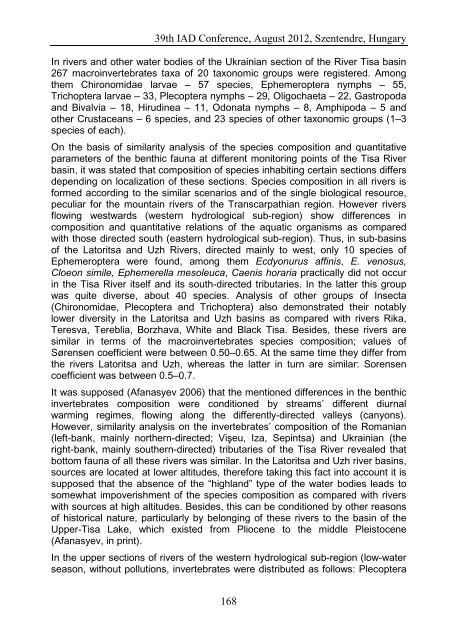Conference Proceedings - IAD
Conference Proceedings - IAD
Conference Proceedings - IAD
You also want an ePaper? Increase the reach of your titles
YUMPU automatically turns print PDFs into web optimized ePapers that Google loves.
39th <strong>IAD</strong> <strong>Conference</strong>, August 2012, Szentendre, Hungary<br />
In rivers and other water bodies of the Ukrainian section of the River Tisa basin<br />
267 macroinvertebrates taxa of 20 taxonomic groups were registered. Among<br />
them Chironomidae larvae – 57 species, Ephemeroptera nymphs – 55,<br />
Trichoptera larvae – 33, Plecoptera nymphs – 29, Oligochaeta – 22, Gastropoda<br />
and Bivalvia – 18, Hirudinea – 11, Odonata nymphs – 8, Amphipoda – 5 and<br />
other Crustaceans – 6 species, and 23 species of other taxonomic groups (1–3<br />
species of each).<br />
On the basis of similarity analysis of the species composition and quantitative<br />
parameters of the benthic fauna at different monitoring points of the Tisa River<br />
basin, it was stated that composition of species inhabiting certain sections differs<br />
depending on localization of these sections. Species composition in all rivers is<br />
formed according to the similar scenarios and of the single biological resource,<br />
peculiar for the mountain rivers of the Transcarpathian region. However rivers<br />
flowing westwards (western hydrological sub-region) show differences in<br />
composition and quantitative relations of the aquatic organisms as compared<br />
with those directed south (eastern hydrological sub-region). Thus, in sub-basins<br />
of the Latoritsa and Uzh Rivers, directed mainly to west, only 10 species of<br />
Ephemeroptera were found, among them Ecdyonurus affinis, E. venosus,<br />
Cloeon simile, Ephemerella mesoleuca, Caenis horaria practically did not occur<br />
in the Tisa River itself and its south-directed tributaries. In the latter this group<br />
was quite diverse, about 40 species. Analysis of other groups of Insecta<br />
(Chironomidae, Plecoptera and Trichoptera) also demonstrated their notably<br />
lower diversity in the Latoritsa and Uzh basins as compared with rivers Rika,<br />
Teresva, Tereblia, Borzhava, White and Black Tisa. Besides, these rivers are<br />
similar in terms of the macroinvertebrates species composition; values of<br />
Sørensen coefficient were between 0.50–0.65. At the same time they differ from<br />
the rivers Latoritsa and Uzh, whereas the latter in turn are similar: Sorensen<br />
coefficient was between 0.5–0.7.<br />
It was supposed (Afanasyev 2006) that the mentioned differences in the benthic<br />
invertebrates composition were conditioned by streams’ different diurnal<br />
warming regimes, flowing along the differently-directed valleys (canyons).<br />
However, similarity analysis on the invertebrates’ composition of the Romanian<br />
(left-bank, mainly northern-directed; Vişeu, Iza, Sepintsa) and Ukrainian (the<br />
right-bank, mainly southern-directed) tributaries of the Tisa River revealed that<br />
bottom fauna of all these rivers was similar. In the Latoritsa and Uzh river basins,<br />
sources are located at lower altitudes, therefore taking this fact into account it is<br />
supposed that the absence of the “highland” type of the water bodies leads to<br />
somewhat impoverishment of the species composition as compared with rivers<br />
with sources at high altitudes. Besides, this can be conditioned by other reasons<br />
of historical nature, particularly by belonging of these rivers to the basin of the<br />
Upper-Tisa Lake, which existed from Pliocene to the middle Pleistocene<br />
(Afanasyev, in print).<br />
In the upper sections of rivers of the western hydrological sub-region (low-water<br />
season, without pollutions, invertebrates were distributed as follows: Plecoptera<br />
168
















